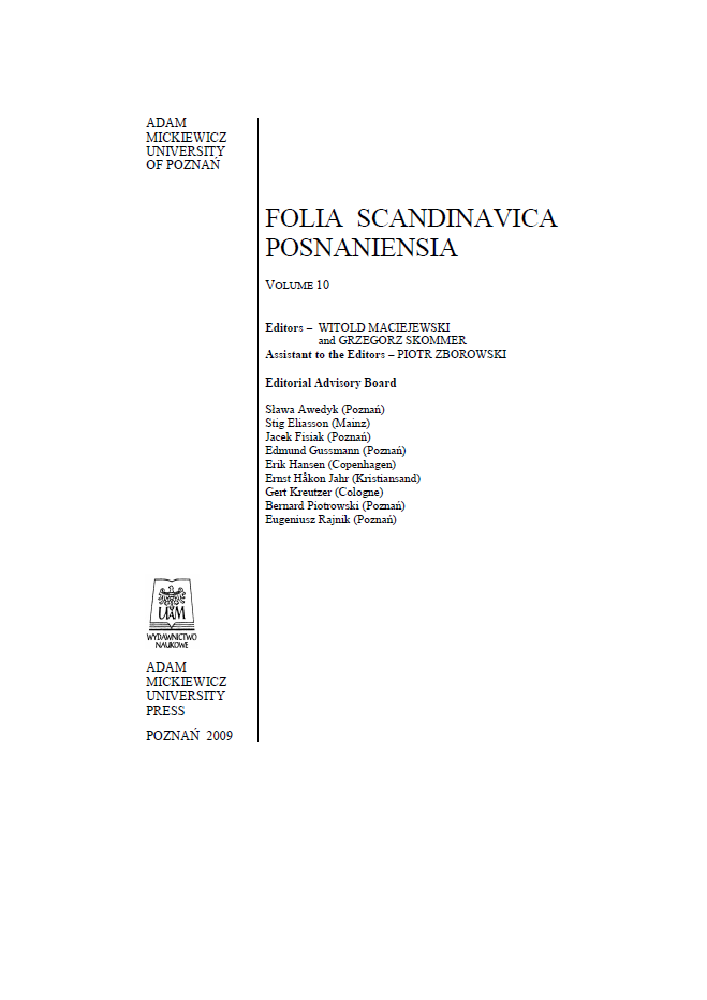Abstract
The article departs from Smith's (1997) claim that verb constellations constituted by a countable nominal, a verb of motion and a directional PP are ACCOMPLISHMENT constellations in line with 'The child built a house' or 'He wrote a novel'. A series of morphological and syntactic tests are applied to perfective and imperfective ACCOMPLISHMENTS of directed motion in Polish and Danish (biec / at løbe, iść / at gå, lecieć / at flyve og jechać / at køre + directional adverbials). This illustrates that the verb constellations of interest do not always show the features of canonical ACCOMPLISHMENTS that do not refer to motion as such.
References
Agrell, Sigurd. 1908. Aspektänderung und Aktionsartbildung beim polnischen Zeitworte: ein Beitrag zum Studium der indogermanischen Präverbia und ihrer Bedeutungsfunktionen. Lund: H. Ohlsson.
Andersson, Erik. 1977. Verbfrasens struktur i svenskan, en studie i aspekt, tempus, tidasdverbial och semantisk räckvidd. PhD Afhandling, Åbo Akademi.
Antinucci, Francesco & Gebert, Lucyna. 1977. Semantyka aspektu czasownikowego. I: Studia Gramatyczne I (= Prace Instytutu Języka Polskiego PAN). Wrocław: Zakład Narodowy im. Ossolińskich, s. 7-43.
Bache, Carl. 1982. Aspect and aktionsart: towards a semantic distinction. Journal of Linguistics 18, s. 57-72.
Borik, Olga. 2006. Aspect and reference time. Oxford: Oxford University Press.
Christensen, Lisa. 1995. Svenskans aktionsarter. En analys med särskild inriktning på förhållandet mellan aktionsarten och presensformens temporala referens. (= Nordlund 20). Lund: Institutionen för nordiska språk, Lunds universitet.
Cockiewicz, Wacław. 1992. Aspekt na tle systemu słowotwórczego polskiego czasownika i jego funkcyjne odpowiedniki w języku niemieckim. Kraków: Wydawnictwo Uniwersytetu Jagiellońskiego.
Comrie, Bernard. 1976. Aspect. Cambridge: Cambridge University Press.
Davidsen-Nielsen, Niels. 1990. Tense and mood in English. A comparison with Danish. Berlin– New York: Mouton de Grutyer.
Depraetere, Ilse. 1995. The effect of temporal adverbials on (a)telicity and (un)boundedness. I: Bertinetto, Pier Marco, Bianchi, Valentina, Higginbotham James & Squartini Mario (eds.).
Temporal Reference, Aspect and Actionality, Vol. 1: Semantic and syntactic perspectives, Torino: Rosenberg and Sellier, s. 43-53.
Engerer, Volkmar. 2003. Tid i sprog – Aktionsartteoriernes fire grundpiller. I: Engerer, Volkmar (temared.). Tid i sprog (= Tidsskrift for Sprogforskning I/2003). Århus: SB-Tryk, s. 21-45.
Gehrke, Berit. 2005. “The prepositional aspect of Slavic prefixes and the goal-source asymmetry.”Presented at the workshop on Formal Semantics and Cross-linguistic Data at the ESSLLI 2005 in Edinburgh, August 15-19.
Jackendoff, Ray. 1996. The proper treatment of measuring out, telicity, and perhaps even quantification in English. Natural Language and Linguistic Theory 14, s. 305-354.
Laskowski, Roman. 1998. Kategorie morfologiczne języka polskiego – charakterystyka funkcjonalna. I: Grzegorczykowa, Renata, Laskowski, Roman & Wróbel, Henryk (red.). Gramatyka współczesnego języka polskiego. Morfologia. Warszawa: Wydawnictwo Naukowe PWN, s. 151-224.
Lyons, John. 1977. Semantics. Vol. 2. Cambridge: Cambridge University Press.
Majewicz, Alfred F. 1985. The grammatical category of aspect in Japanese and Polish in a comparative perspective. A typological study. Poznań: Wydawnictwo Naukowe UAM.
Malmgren, Sven-Göran. 1990. Adjektiviska funktioner i svenskan. (= Nordistica Gothoburgensia 13). Göteborg: Acta Universitatis Gothoburgensis.
Mittwoch, Anita. 1982. On the difference between eating and eating something: activities versus accomplishments. Linguistic Inquiry 13(1), s. 113-122.
Rajnik, Eugeniusz. 1999. Gramatyka języka duńskiego. Morfologia. Poznań: Wydawnictwo Naukowe
UAM.
Smith, Carlota. 1997. The parameter of aspect, Dordrecht–Boston–London: Kluwer.
Śmiech, Witold. 1986. Derywacja prefiksalna czasowników polskich. Wrocław: Zakład Narodowy im. Ossolińskich – Wydawnictwo.
Tungseth, Mai. 2002. “PP, PathP and the telic/atelic distinction in Norwegian motion constructions.” Presented at NSF-Funded Workshop on the Syntax, Semantics & Acquisition of Aspect,
University of Iowa. [Kan hentes på http://www.uiowa.edu/~linguist/workshop/papers/].
Vendler, Zeno. (1967) 2005. Verbs and times. I: Mani, Inderjeet, Pustejovsky, James & Gaizauskas, Rob (red.). The language of time. A reader. Oxford University Press, s. 21-32.
Vikner, Sten & Vikner, Carl. 1997. The aspectual complexity of the simple past in English. A comparison with French and Danish. I: Bache, Carl & Klinge, Alex (red.). Sounds, structures
and senses. Essays presented to Niels Davidsen-Nielsen on the occasion of his sixtieth birthday. Odense: Odense University Press, s. 267-284.
Willim, Ewa. 2007. “Are prefixed verbs of directed motion resultative in Polish?” Presented at 7th European Conference on Formal Description of Slavic Languages, Leipzig.
Østergaard, Frede. 1979. The progressive aspect in Danish. I: Pettersson, Thore (ed.), Aspectology. Workshop at the Fifth Scandinavian Conference of Linguistics. Frostavallen, April 27-29
Stockholm: Almquist och Wiksell International, s. 89-109.
License
Copyright (c) 2015 Mikołaj Sobkowiak

This work is licensed under a Creative Commons Attribution-NonCommercial-NoDerivatives 3.0 Unported License.
